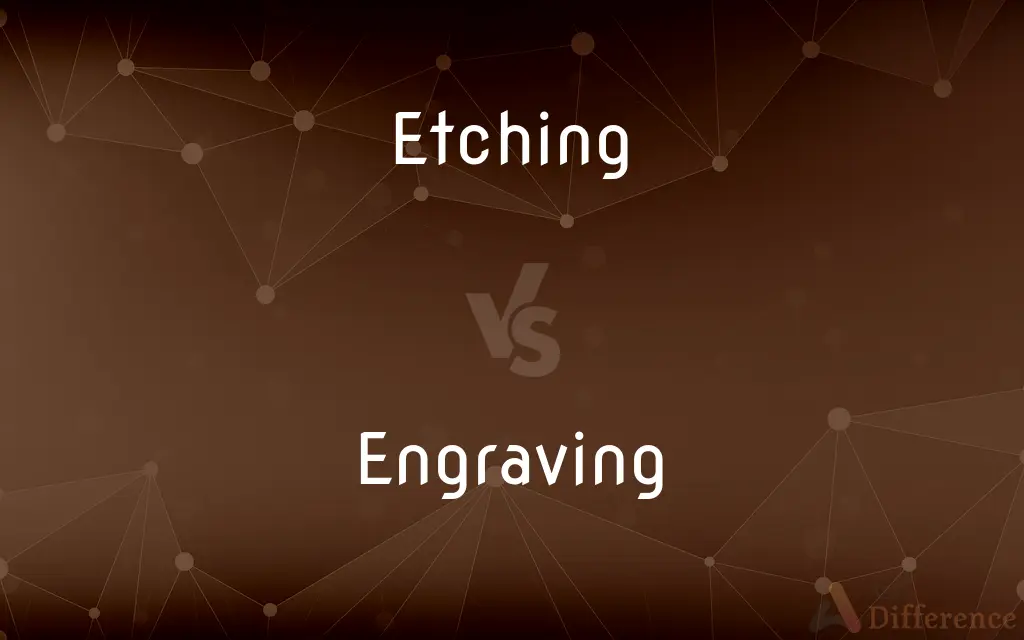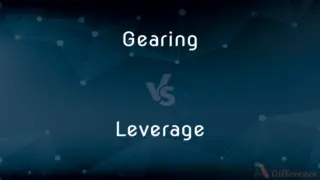Etching vs. Engraving — What's the Difference?
By Tayyaba Rehman & Urooj Arif — Updated on March 13, 2024
Etching uses chemical processes to create designs on metal surfaces, while engraving involves cutting or carving directly into the material with tools or machines.

Difference Between Etching and Engraving
Table of Contents
ADVERTISEMENT
Key Differences
Etching is an art form that involves coating a metal plate with a protective layer, drawing a design, and then using acid or another mordant to eat away exposed areas, creating recessed lines that hold ink for printing. On the other hand, engraving is a more direct technique where an artist or craftsman uses tools to cut or carve lines directly into the surface of various materials, not limited to metal.
While etching is primarily associated with printmaking and metal surfaces, engraving extends to a broader range of materials, including wood, glass, and plastic, making it versatile in applications from art to industrial marking. The chemical process of etching offers a different kind of artistic expression, allowing for subtle gradations and a softer line quality compared to the sharp, clean lines produced by engraving tools.
The choice between etching and engraving can depend on the desired outcome, the material in question, and the artist's or craftsman's expertise. Etching might be preferred for detailed graphic works on metal plates intended for printing, whereas engraving might be chosen for durable and direct marking on various objects, from jewelry to signage. Both techniques require specialized skills and equipment, with etching necessitating knowledge of chemical processes and engraving requiring precision in manual or machine tooling.
Despite their differences, both etching and engraving share the goal of creating lasting designs and are chosen for their ability to produce works with depth, texture, and detail that flat images cannot achieve. The decision between etching and engraving often comes down to the specific requirements of the project, including the level of detail needed, the type of material being worked on, and the intended use of the finished piece.
Comparison Chart
Method
Uses chemicals to create designs.
Involves cutting or carving into the material.
ADVERTISEMENT
Materials
Primarily metals for printmaking.
Metals, wood, glass, plastic, and more.
Detail & Texture
Nuanced shades and textures; softer lines.
Precise, clean lines with depth.
Tools & Equipment
Acid or mordants, protective coatings.
Engraving tools or machines.
Application
Artistic printmaking, decorative metalwork.
Jewelry, awards, industrial marking, decorative items.
Skill & Knowledge
Understanding of chemical processes.
Precision in manual or machine tooling.
Outcome
Recessed lines that hold ink for printing.
Designs that can be felt as well as seen.
Historical Use
Known for its artistic expression.
Widely used for its durability and versatility in marking.
Compare with Definitions
Etching
A printmaking technique using acid to create designs on metal.
Rembrandt's etchings are celebrated for their intricate detail.
Engraving
A method of cutting or carving designs into materials.
The engraved silverware added elegance to the dining table setting.
Etching
Creates recessed lines for ink retention.
The metal plate was etched carefully to produce the desired image on paper.
Engraving
Versatile across various materials.
Engraving techniques are used on everything from wood to glass and metal.
Etching
Involves a chemical process for artistic expression.
The etching process allowed for subtle shading in the artist's work.
Engraving
Offers precision and depth in design.
The engraving on the watch was done with exceptional detail.
Etching
Often used in fine art and detailed metalwork.
The intricate etching on the metal plaque added a sophisticated touch.
Engraving
Employed in both art and industrial applications.
Industrial engraving is essential for part identification and branding.
Etching
Known for nuanced textures and tones.
Etching gives a unique texture that differs from direct carving or cutting methods.
Engraving
Known for its durability and tactile quality.
The engraved message on the stone monument has withstood the test of time.
Etching
Etching is traditionally the process of using strong acid or mordant to cut into the unprotected parts of a metal surface to create a design in intaglio (incised) in the metal. In modern manufacturing, other chemicals may be used on other types of material.
Engraving
Engraving is the practice of incising a design onto a hard, usually flat surface by cutting grooves into it with a burin. The result may be a decorated object in itself, as when silver, gold, steel, or glass are engraved, or may provide an intaglio printing plate, of copper or another metal, for printing images on paper as prints or illustrations; these images are also called "engravings".
Etching
The art of preparing etched plates, especially metal plates, from which designs and pictures are printed.
Engraving
The art or technique of one that engraves.
Etching
A design etched on a plate.
Engraving
A design or text engraved on a surface.
Etching
An impression made from an etched plate.
Engraving
An engraved surface for printing.
Etching
(uncountable) The art of producing an image from a metal plate into which an image or text has been etched with acid.
Engraving
A print made from an engraved plate or block.
Etching
(countable) The image created by this process.
Engraving
(art) The practice of incising a design onto a hard, flat surface, by cutting grooves into it.
Etching
Present participle of etch
Engraving
(printing) The art of producing an image from an engraved printing form, typically made of copper.
Etching
A design carried out by means of the above process; a pattern on metal, glass, etc., produced by etching.
Engraving
(countable) A print produced from an engraving.
Etching
An impression on paper, parchment, or other material, taken in ink from an etched plate.
Engraving
(music) The art of drawing music notation at high quality, particularly on a computer.
Etching
An impression made from an etched plate
Engraving
Present participle of engrave
Etching
An etched plate made with the use of acid
Engraving
The act or art of producing upon hard material incised or raised patterns, characters, lines, and the like; especially, the art of producing such lines, etc., in the surface of metal plates or blocks of wood. Engraving is used for the decoration of the surface itself; also, for producing an original, from which a pattern or design may be printed on paper.
Etching
Making engraved or etched plates and printing designs from them
Engraving
That which is engraved; an engraved plate.
Engraving
An impression from an engraved plate, block of wood, or other material; a print.
Engraving
A print made from an engraving
Engraving
A block or plate that has been engraved
Engraving
Making engraved or etched plates and printing designs from them
Common Curiosities
What is etching?
Etching is a printmaking technique that uses chemical processes to create designs on metal plates, resulting in detailed prints.
Is engraving limited to artistic applications?
No, engraving is widely used in industrial applications, jewelry making, and personalized items, among others.
Can etching and engraving be combined in a single piece?
Yes, artists and craftsmen sometimes combine both techniques to exploit their unique advantages in a single work.
Is there a significant cost difference between etching and engraving?
Costs can vary depending on the complexity of the design and the material used, with some engraving methods, especially machine engraving, potentially being more cost-effective at scale.
Can etching be used on materials other than metal?
While traditionally associated with metal, modern etching techniques may extend to other materials using similar principles.
How does the detail in etching compare to engraving?
Etching allows for fine details and subtle shading, whereas engraving offers clean, precise lines with depth.
How durable are etched and engraved designs?
Both techniques produce durable designs, but engraving may offer greater longevity, especially on hard materials.
What is engraving?
Engraving involves cutting or carving designs directly into materials, creating detailed and tactile works.
How do environmental factors affect etched and engraved pieces?
While both are generally durable, engraved pieces may better withstand harsh conditions due to the physical depth and absence of chemicals.
Are special skills required for etching and engraving?
Yes, both techniques require specialized knowledge and skills, with etching focusing on chemical processes and engraving on precision tooling.
Share Your Discovery

Previous Comparison
Nona vs. Nonna
Next Comparison
Gearing vs. LeverageAuthor Spotlight
Written by
Tayyaba RehmanTayyaba Rehman is a distinguished writer, currently serving as a primary contributor to askdifference.com. As a researcher in semantics and etymology, Tayyaba's passion for the complexity of languages and their distinctions has found a perfect home on the platform. Tayyaba delves into the intricacies of language, distinguishing between commonly confused words and phrases, thereby providing clarity for readers worldwide.
Co-written by
Urooj ArifUrooj is a skilled content writer at Ask Difference, known for her exceptional ability to simplify complex topics into engaging and informative content. With a passion for research and a flair for clear, concise writing, she consistently delivers articles that resonate with our diverse audience.















































